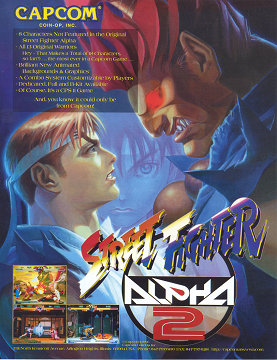
Street Fighter Alpha 2, known as Street Fighter Zero 2 in Japan, Asia, South America, and Oceania, is a 1996 fighting game originally released for the CPS II arcade hardware by Capcom. The game is a remake to the previous year's Street Fighter Alpha: Warriors' Dreams. The game features a number of improvements over the original, such as new attacks, stages, endings, and gameplay features. It was followed by Street Fighter Alpha 3.
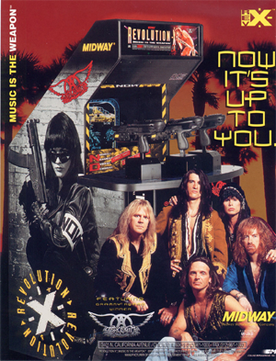
Revolution X is a shooting gallery video game developed by Midway and released in arcades in 1994. The gameplay is similar to Midway's earlier Terminator 2: Judgment Day, but is themed around the band Aerosmith. The oppressive New Order Nation regime and their leader Helga have abducted Aerosmith, and players use a mounted gun to control onscreen crosshairs and shoot enemies. The members of Aerosmith are hidden throughout the game's international locales and must be found in order to receive the game's true ending.
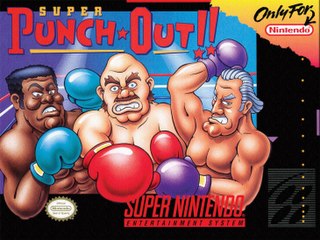
Super Punch-Out!! is a boxing video game developed and published by Nintendo for the Super Nintendo Entertainment System (SNES). It was released on September 14, 1994 in North America and again in the same region in 1996. It was released in Europe on January 26, 1995 for the same console and in Japan in 1998 for the Nintendo Power flash RAM cartridge series and the Super Famicom. The game is also included in the GameCube version of Fight Night Round 2 as an extra game due to the inclusion of Little Mac in the game. The game was released for the Wii's Virtual Console in Europe on March 20, 2009, in North America on March 30, 2009, and in Japan on July 7, 2009. The game was also released on the New Nintendo 3DS eShop on May 5, 2016. Nintendo re-released Super Punch-Out!! in the United States in September 2017 as part of the company's Super NES Classic Edition. It is the fourth game in the Punch-Out!! series, taking place after the Punch-Out!! game for the Nintendo Entertainment System (NES).

Tomcat Alley is an interactive movie FMV video game developed by The Code Monkeys for Sega CD. It was the first Sega CD game to feature extensive full screen, full motion video. It was later released, with higher quality video, for Windows-based PCs. A 32X version was also in development, but never released.

Weaponlord is a fighting game developed by Visual Concepts and published by Namco for the Super NES and Genesis in October 1995. Weaponlord has players select a character and defeat a series of opponents. The game is a weapons-based fighter, with various gory moves and a deep counterattack system.
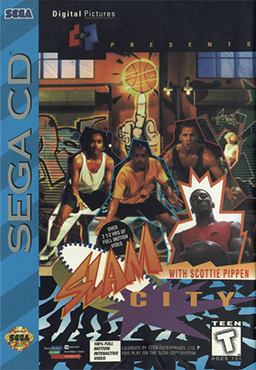
Slam City with Scottie Pippen is the first FMV basketball video game. It was developed by Digital Pictures for the PC and CD-ROM-based video game consoles such as the Sega CD. Scottie Pippen stars in the game, and performed the theme song. Ron Stein, who had previously directed the video footage for Prize Fighter, directed the video footage for the game. A 3DO Interactive Multiplayer version was announced but never released.

Alien Trilogy is a first-person shooter video game developed by Probe Entertainment and published by Acclaim Entertainment in 1996 for the PlayStation, Sega Saturn, and MS-DOS platforms. The game is based on the first three movies in the Alien film series. One of the first games developed by Probe following their acquisition by Acclaim, it debuted Acclaim's much-hyped motion capture technology. The game was well-received by critics, who praised its recreation of the films' atmosphere and its gameplay depth compared to other first-person shooters, and was a commercial success.
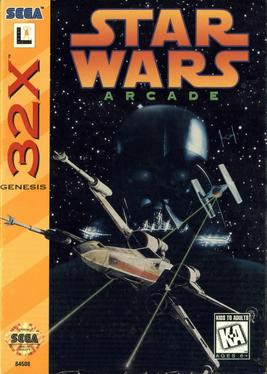
Star Wars is a 1993 arcade game developed by Sega and based on the original Star Wars trilogy. Combining elements of A New Hope and Return of the Jedi, the game has players pilot a Rebel starship and battle against the forces of the Empire. Sega developed Star Wars for their Model 1 system, the same arcade hardware that powered Virtua Fighter and Virtua Racing. Like those two titles, the graphics in Star Wars are rendered entirely using polygons. The game was given a home port under the name Star Wars Arcade, as an exclusive for the Sega 32X's launch in 1994.
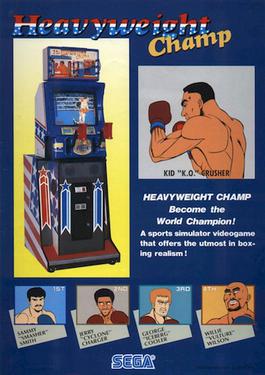
Heavyweight Champ is a series of boxing video games released by Sega. The original arcade game was released in 1976. The game featured black-and-white graphics and critics have since identified it as the first video game to feature hand-to-hand fighting. It was a commercial success in Japan, where it was the third highest-grossing arcade video game of 1976. However, it is now considered a lost video game.

Riddick Bowe Boxing is a multiplatform boxing video game released in 1993. It was also released for the Game Boy and Game Gear consoles.
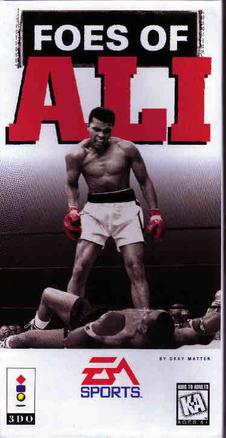
Foes of Ali is a boxing video game that was developed by Gray Matter and published by EA Sports in 1995. It was released exclusively for the 3DO Interactive Multiplayer console. It was one of the first boxing games to render matches using 3D graphics. Thus, boxers in the game could be shown to move 360 degrees around the ring in a more convincing fashion than had previously been possible using 2D sprites. The gameplay bears many similarities to that featured in 4D Sports Boxing.

Greatest Heavyweights is a boxing video game that was published by Sega in 1993. It was released for the Sega Genesis console. It is a follow-up to Evander Holyfield's Real Deal Boxing, and is virtually identical in many ways, apart from a number of significant improvements.
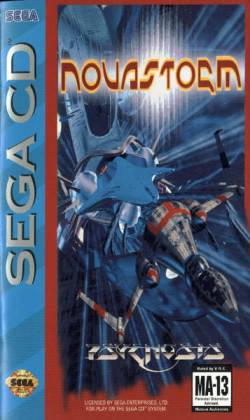
Novastorm is a rail shooter developed by Psygnosis in 1994. A version for the FM-Towns/Marty systems had previously been released under the name Scavenger 4.

Off-World Interceptor is a third-person vehicular car combat game, released for the 3DO. An alternate version of the game was later released for the Sega Saturn and PlayStation consoles, named Off-World Interceptor Extreme. The two versions of the game have identical core gameplay elements, though the Extreme version is tweaked to feel more like the arcade mode in the original Off-World Interceptor.

Total Eclipse is a space flight simulation video game developed and published by Crystal Dynamics for 3DO. It was later ported to the PlayStation under the title Total Eclipse Turbo. The game was copyrighted in 1993 and released 1994. Total Eclipse Turbo was a launch title for the PlayStation in the U.S., with the game's released date predating the North American console launch by 11 days. A sequel, Solar Eclipse, was released for Sega Saturn and PlayStation.

Supreme Warrior is a full-motion video (FMV) beat 'em up game developed by Digital Pictures. It was released for the 3DO Interactive Multiplayer and Sega CD in November 1994 in North America and in early 1995 in Europe, with subsequent releases in 1995 for the 32X, Macintosh, and Windows. The game is themed as a kung fu film where the player has to fight off opponents to protect half of a magical mask.

BattleSport is a 1996 futuristic sports video game developed by Cyclone Studios. It was originally published by Studio 3DO exclusively for their 3DO Interactive Multiplayer in 1996, but after the 3DO was discontinued BattleSport was published for other systems by Acclaim Entertainment. It was released for Windows and PlayStation in North America on June 30, 1997, and in Europe on August 1, 1997. It also saw a US only release on the Saturn.
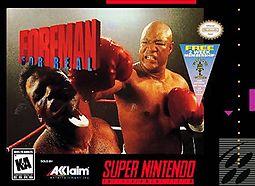
Foreman For Real is a 1995 boxing video game for the Game Boy, Game Gear, Sega Genesis, and the Super Nintendo Entertainment System featuring George Foreman. It is the follow-up to Acclaim's previous release, George Foreman's KO Boxing. The game was met with negative reviews which criticized the simplistic and unexciting gameplay and low production values.
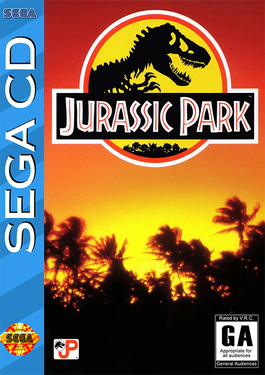
Jurassic Park is a 1994 point-and-click adventure game developed and published by Sega for the Sega CD. The video game is based on the 1993 film of the same name, and includes elements from Michael Crichton's 1990 novel Jurassic Park, which the film is based upon.

Road Rash is a 1994 racing and vehicular combat video game originally published by Electronic Arts (EA) for the 3DO Interactive Multiplayer. A version for the Sega CD was developed simultaneously and released in 1995 to act as a "bridge" between the 3DO version and the Sega Genesis title Road Rash 3, and the game was subsequently ported to the PlayStation, Sega Saturn and Microsoft Windows in 1996. The game is the third installment in the Road Rash series, and is centered around a series of motorcycle races throughout California that the player must win to advance to higher-difficulty races, while engaging in unarmed and armed combat to hinder the other racers.




















